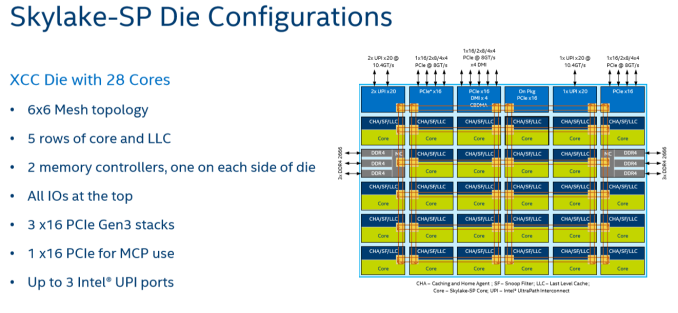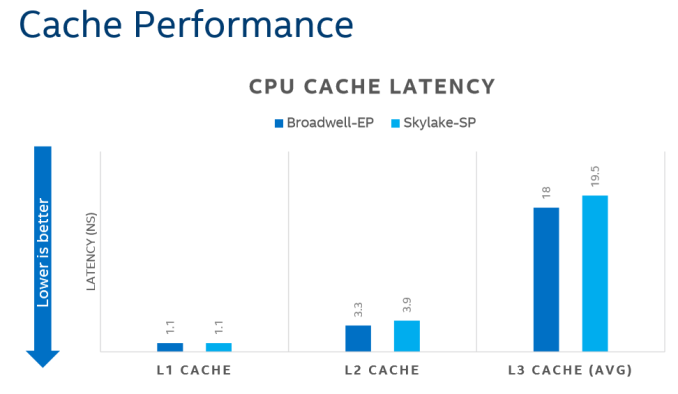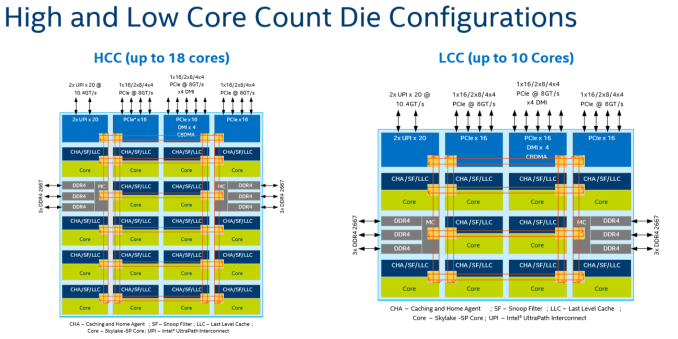Sizing Up Servers: Intel's Skylake-SP Xeon versus AMD's EPYC 7000 - The Server CPU Battle of the Decade?
by Johan De Gelas & Ian Cutress on July 11, 2017 12:15 PM EST- Posted in
- CPUs
- AMD
- Intel
- Xeon
- Enterprise
- Skylake
- Zen
- Naples
- Skylake-SP
- EPYC
Intel's New On-Chip Topology: A Mesh
Since the introduction of the "Nehalem" CPU architecture – and the Xeon 5500 that started almost a decade-long reign for Intel in the datacenter – Intel's engineers have relied upon a low latency, high bandwidth ring to connect their cores with their caches, memory controllers, and I/O controllers.
Intel's most recent adjustment to their ring topology came with the Ivy Bridge-EP (Xeon E5 2600 v2) family of CPUs. The top models were the first with three columns of cores connected by a dual ring bus, which utilized both outer and inner rings. The rings moved data in opposite directions (clockwise/counter-clockwise) in order to minimize latency by allowing data to take the shortest path to the destination. As data is brought onto the ring infrastructure, it must be scheduled so that it does not collide with previous data.
The ring topology had a lot of advantages. It ran very fast, up to 3 GHz. As result, the L3-cache latency was pretty low: if the core is lucky enough to find the data in its own cache slice, only one extra cycle is needed (on top of the normal L1-L2-L3 latency). Getting a cacheline of another slice can cost up to 12 cycles, with an average cost of 6 cycles.
However the ring model started show its limits on the high core count versions of the Xeon E5 v3, which had no less than four columns of cores and LLC slices, making scheduling very complicated: Intel had to segregate the dual ring buses and integrate buffered switches. Keeping cache coherency performant also became more and more complex: some applications gained quite a bit of performance by choosing the right snoop filter mode (or alternatively, lost a lot of performance if they didn't pick the right mode). For example, our OpenFOAM benchmark performance improved by almost 20% by choosing "Home Snoop" mode, while many easy to scale, compute-intensive applications preferred "Cluster On Die" snooping mode.
In other words, placing 22 (E7:24) cores, several PCIe controllers, and several memory controllers was close to the limit what a dual ring could support. In order to support an even larger number of cores than the Xeon v4 family, Intel would have to add a third ring, and ultimately connecting 3 rings with 6 columns of cores each would be overly complex.
Given that, it shouldn't come as a surprise that Intel's engineers decided to use a different topology for Skylake-SP to connect up to 28 cores with the "uncore." Intel's new solution? A mesh architecture.
Under Intel's new topology, each node – a caching/home agent, a core, and a chunk of LLC – is interconnected via a mesh. Conceptually it is very similar to the mesh found on Xeon Phi, but not quite the same. In the long-run the mesh is far more scalable than Intel's previous ring topology, allowing Intel to connect many more nodes in the future.
How does it compare to the ring architecture? The Ring could run at up to 3 GHz, while the current mesh and L3-cache runs at at between 1.8GHZ and 2.4GHz. On top of that, the mesh inside the top Skylake-SP SKUs has to support more cores, which further increases the latency. Still, according to Intel the average latency to the L3-cache is only 10% higher, and the power usage is lower.
A core that access an L3-cache slice that is very close (like the ones vertically above each other) gets an additional latency of 1 cycle per hop. An access to a cache slice that is vertically 2 hops away needs 2 cycles, and one that is 2 hops away horizontally needs 3 cycles. A core from the bottom that needs to access a cache slice at the top needs only 4 cycles. Horizontally, you get a latency of 9 cycles at the most. So despite the fact that this Mesh connects 6 extra cores verse Broadwell-EP, it delivers an average latency in the same ballpark (even slightly better) as the former's dual ring architecture with 22 cores (6 cycles average).
Meanwhile the worst case scenario – getting data from the right top node to the bottom left node – should demand around 13 cycles. And before you get too concerned with that number, keep in mind that it compares very favorably with any off die communication that has to happen between different dies in (AMD's) Multi Chip Module (MCM), with the Skylake-SP's latency being around one-tenth of EPYC's. It is crystal clear that there will be some situations where Intel's server chip scales better than AMD's solution.
There are other advantages that help Intel's mesh scale: for example, caching and home agents are now distributed, with each core getting one. This reduces snoop traffic and reduces snoop latency. Also, the number of snoop modes is reduced: no longer do you need to choose between home snoop or early snoop. A "cluster-on-die" mode is still supported: it is now called sub-NUMA Cluster or SNC. With SNC you can divide the huge Intel server chips into two NUMA domains to lower the latency of the LLC (but potentially reduce the hitrate) and limit the snoop broadcasts to one SNC domain.














219 Comments
View All Comments
alpha754293 - Tuesday, July 11, 2017 - link
Pity that OpenFOAM failed to run on Ubuntu 16.04.2 LTS. I would have been very interested in those results.farmergann - Tuesday, July 11, 2017 - link
Are you trying to hide the fact that AMD's performance per watt absolutely dominates intel's, or have you simply overlooked one of, if not the, single most important aspects of server processors?Ryan Smith - Tuesday, July 11, 2017 - link
Neither. We just had very little time to look at power consumption. It's also the metric we're the least confident in right now, as we'd like to have a better understanding of the quirks of the platform (which again takes more time).Carl Bicknell - Wednesday, July 12, 2017 - link
Ryan / Ian,Just to let you know there are better chess benchmarks than the one you've chosen. Stockfish is an example of a newer program which better uses modern CPU architecture.
NixZero - Tuesday, July 11, 2017 - link
"AMD's MCM approach is much cheaper to manufacture. Peak memory bandwidth and capacity is quite a bit higher with 4 dies and 2 memory channels per die. However, there is no central last level cache that can perform low latency data coordination between the L2-caches of the different cores (except inside one CCX). The eight 8 MB L3-caches acts like - relatively low latency - spill over caches for the 32 L2-caches on one chip. "isnt skylake-x's l3 a victim cache too? and divided at 1.3mb for each core, not a monolytic one?
Ian Cutress - Tuesday, July 11, 2017 - link
That's what a 'spill-over' cache is - it accepts evicted cache lines.NixZero - Wednesday, July 12, 2017 - link
so why its put as an advantage for intel cache, which is spill over too?JonathanWoodruff - Wednesday, July 12, 2017 - link
Since the Intel one is all on one die, a miss to a "slice" of cache can be filled without DRAM-like latencies from another slice. Since AMD has it's last level caches spread across dies, going to another cache looks to be equivalent latency-wise to going to DRAM. It wouldn't necessarily have to be quite that bad, and I would expect some improvement here for Zen2.Martin_Schou - Tuesday, July 11, 2017 - link
This has to be wrong:CPU Two EPYC 7601 (2.2 GHz, 32c, 8x8MB L3, 180W)
RAM 512 GB (12x32 GB) Samsung DDR4-2666 @2400
12 x 32 GB is 384 GB, and 12 sticks doesn't fit nicely into 8 channels. In all likelihood that's supposed to be 16x32 GB, as we see in the E52690
Dr.Neale - Tuesday, July 11, 2017 - link
I find myself puzzled by the curious omission in this article of a key aspect of Server architecture: Data Security.AMD has a LOT; Intel, not so much.
I would think this aspect of Server "Performance" would be a major consideration in choosing which company's Architecture to deploy in a Secure Server scenario. Especially in light of Recent Revelations fuelling Hacking Headlines in the news, and Dominating Discussions on various social media websites.
How much is Data Security worth?
A topic of EPYC consequence!